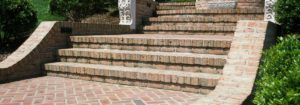
Brick and concrete pavers for patios, driveways and walkways are a perennial favorite. Both are extremely durable, easily maintained materials that offer a lifetime of beauty to the space. They are installed the same way and offer years of durability as well. Considered chic today, modern versions of brick and concrete pavers offer a status symbol.
When you have the option between brick and concrete, don’t be side-tracked by the good looks. With that in mind, here are the three ways to choose between a brick and concrete paver for your home.
Color, Makeup and Type
Bricks are made of clay by baking in a kiln. There are concrete paver materials that are technically aren’t bricks but look like they are. These pavers shouldn’t be confused with actual bricks. Real bricks are naturally colored and retain that color better than concrete. They last for generations although they may chip or crack with time and use. Bricks are easy to maintain, resist staining and require cleaning less often than concrete. They have a distinct edge in look which makes them more appealing for homes that have a traditional touch. Bricks are of the type that are eco-friendly as well which means they can be salvaged, cleaned and reused as many times as possible without losing the originality. Concrete paver types on the other hand are made from cement, poured into forms and cured to get the required shape. They are flexible compared to bricks and fit all types of spaces in contemporary homes.
Difference in Price
Concrete paver is less expensive compared to brick paver. This is mainly due to the lower cost of materials used for concrete. There are also more choices in design and color with these pavers making is cost effective for modular homes. They are easier to cut, require less labor, and are a popular choice for DIY projects. New and better concrete paver driveways are designed all the time due to low cost as well as availability and innovation. Brick pavers, on the other hand, can be up to 20 percent more expensive than concrete. They are limited in choice, color and patterns. Most bricks pavers come in natural clay, generally rectangular in shape and are limited in size. Due to these limitations, brick pavers are trickier to install and require skilled workers to do the job. Brick pavers are more likely to crack under heavy traffic and therefore require constant touch-up from professionals.
Features in Depth
Concrete paver’s color can fade over time, especially in sunny regions, losing its smooth finish and exposing the roughness underneath. This is mainly because concrete is dyed with color pigments and aren’t natural like bricks. Adding to the woes is the periodical wear and tear of the material which calls for additional sealant in order to maintain the originality and look. Bricks, on the other hand, tend to wear quickly by chipping and cracking compared to concrete that wears gradually. Concrete varies in durability and strength, which largely depends on the manufacturer and price. Sometimes, it is hard to tell the exact quality of concrete paver unless more investigation is done in terms of makeup and material. There are excellent concrete paver varieties that look like natural stone and are easier to work with. Then there are worst quality concrete paver types that can crumble and crack even before laying them on the floor. Your decision to use such concrete pavers, even as a section of the walkway, requires commitment to long-term maintenance and keeping it sealed. In addition, given concerns about fading, you will have to properly maintain it to last for more than a decade.
